A California Scrub Jay cocks its head at the camera. Photo by Christy Wyckoff.
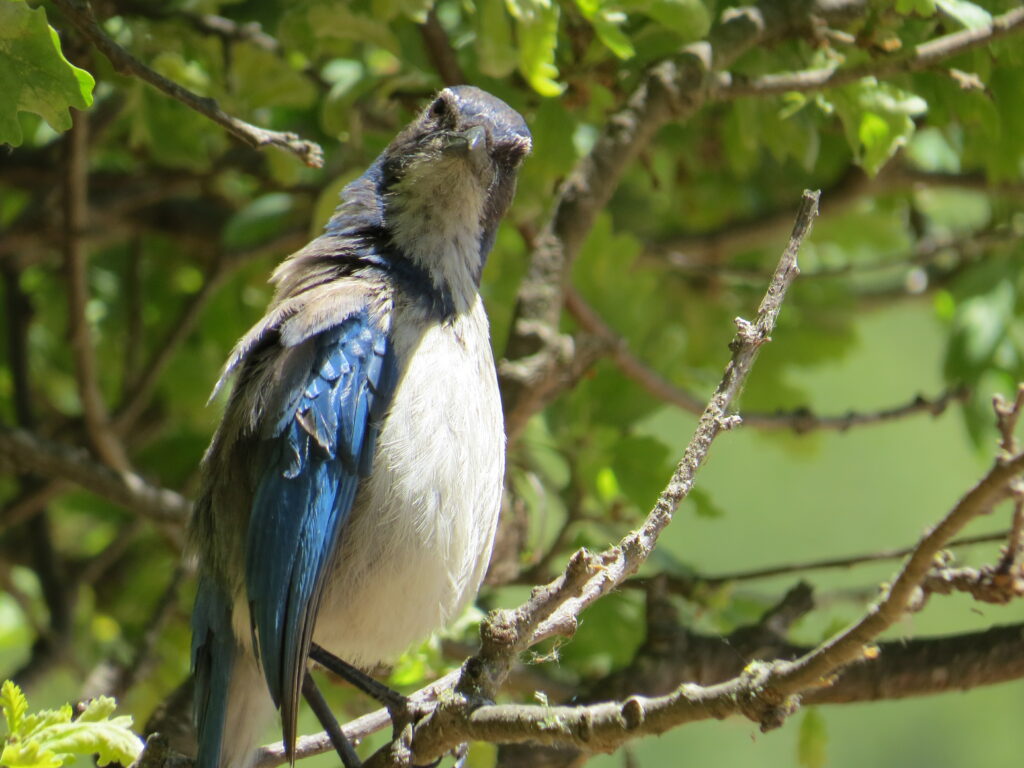
9 Common Birds in the Santa Lucia Mountains
November 10, 2022
By Alix Soliman, Communications & Outreach Coordinator
Birding on the Central Coast of California is a rich experience for new birders and old-timers alike, with almost 500 species identified in Monterey County alone. This area is centrally located within a major north-south bird migration path known as the Pacific Flyway, which encompasses diverse and distinct habitat types that support a high rate of biodiversity.
The Santa Lucia Range runs from the south side of Carmel Valley down scenic Highway 1 to San Luis Obispo and includes The Santa Lucia Preserve, Garrapata State Park, Garland Ranch Regional Park, Big Sur, and Los Padres National Forest among other hiking areas. While you take in the expansive coastal views and undulating hills of grasslands, savannas, redwood forests, chaparral and oak woodlands, we encourage readers to grab a pair of binoculars and look deeper into the lives of nine common land bird species you are likely to see in this rugged range:
1. California Quail (Callipepla californica)
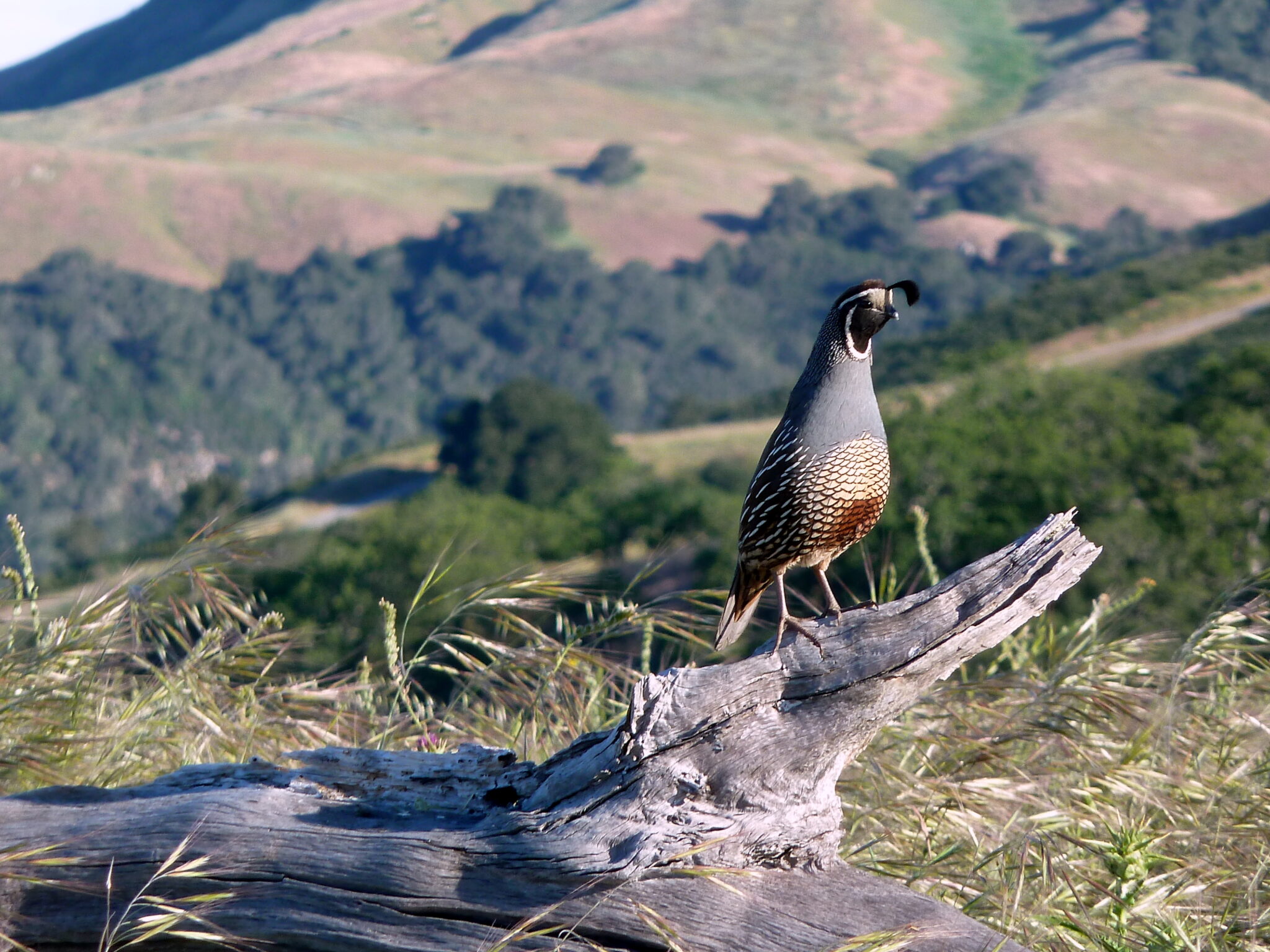
Photo by Chris Wilson.
Usually spotted dashing into the bushes, the California state bird is a shy, ground-dwelling species that lives in groups called “coveys.” California Quail are easily identified by their plump pear shape, black plume of 6 feathers on their head known as a “topknot,” scaled black-and-white belly, chestnut patches, and distinctive black-and-white facial markings. Their main call is three syllables and almost sounds like “Chi-CA-go.” Although they are capable of flying about 100 yards, they normally only do so when threatened in a behavior called “flushing.” They prefer to stick to the ground in chaparral and oak woodland habitats where they nest and forage for seeds, leaves, poison oak berries, and insects. Females lay clutches of 12-16 eggs once or twice per year, and all adults in the group share parenting responsibilities. Families can group together into “communal broods” which include at least two reproducing females and multiple males. These multi-family groups can contain 75 individuals, though groups of 10-20 are more common. Well adapted to the arid west, the California Quail can acquire water from the leaves and insects in their diet. However, they must find drinking water to survive periods of sustained heat and drought. A delicious and nutritious meal for predators like coyotes, foxes, bobcats, owls, and snakes, quail are often hunted before they reach their second birthday and rarely die of old age.
2. California Scrub-Jay (Aphelocoma californica)
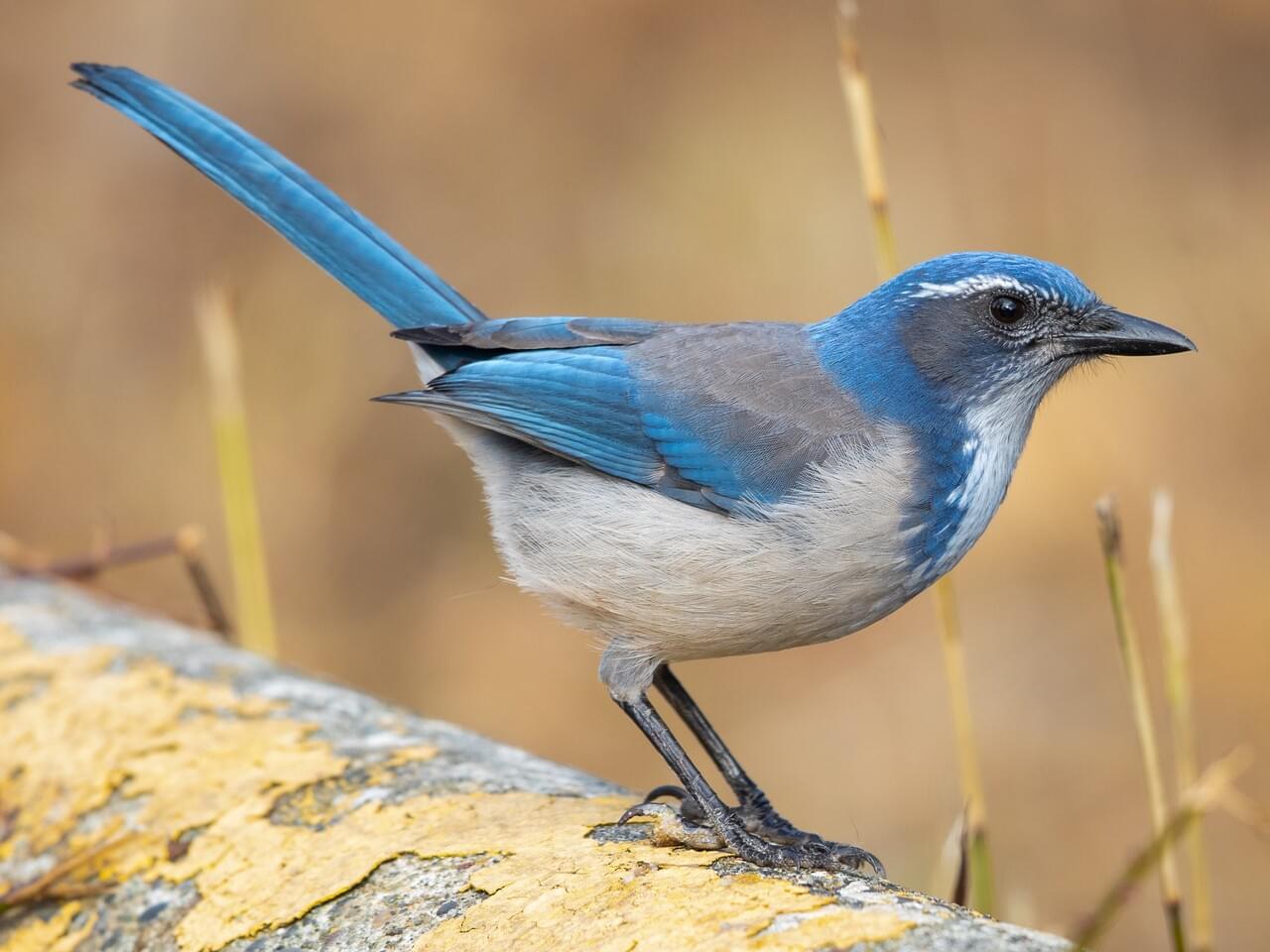
Photo Courtesy of Ilya Povalyaev / Macaulay Library.
Bold and cacophonous, the California Scrub-Jay announces itself with loud, raspy squawks. Extremely animated birds, they playfully swoop, hop, and cock their heads to the side and are not afraid to approach humans. Often incorrectly called Blue Jays (which are found east of the Rocky Mountains) California Scrub-Jays can be identified by their rich blue head, wings, and tail, dark eye patch, white belly, and white eyebrows. Common in chaparral and oak woodland habitats, California Scrub-Jays have a seasonal diet, eating insects and fruit in the spring and summer and then switching to nuts and seeds during the fall and winter (especially acorns). They will also occasionally eat lizards, nestling birds, and ticks from the backs of mule deer. Breeding pairs aggressively defend their territories year-round, sparring with other jays and even chasing off red-tailed hawks. A member of the corvid family alongside ravens, crows, and magpies, California Scrub-Jays are remarkably intelligent, social, and long-lived birds. They can live to be over 15 years old in the wild and have been observed mourning their dead. Scrub-Jays will screech over the body in a group for about 30 minutes and remain near their fallen friend for a couple of days.
3. Bushtit (Psaltriparus minimus)
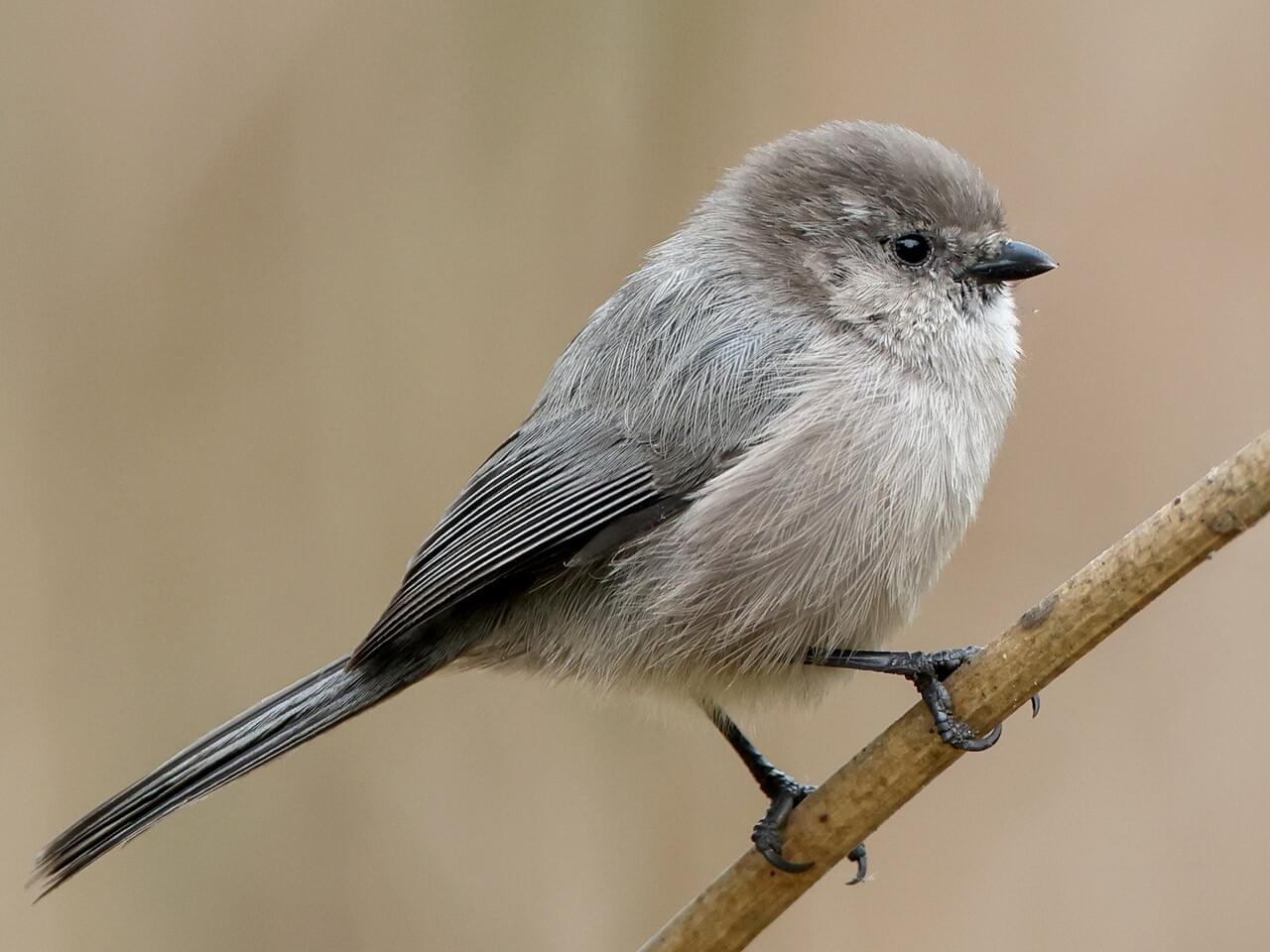
Photo courtesy of Paul Fenwick / Macaulay Library.
Bushtits are tiny, round, and gray songbirds that are often seen nimbly bouncing around the low branches of woodland edges and scrubby areas. Please note that this species can be confused with other small, drab birds like the Blue-gray Gnatcatcher (which can be distinguished by its smaller head, longer bill, white eye ring, and black tail). They travel in flocks of 10-40 and call to each other in rapid, high-pitched chirps and twitters. A majority of their diet consists of small insects and spiders, including aphids, beetles, caterpillars, wasps, and ants. Bushtits weave an intricate hanging nest approximately one foot long and made of moss, spider webs, and grass. Shaped roughly like a wide sock, the entry and exit hole is found at the top. During the breeding season, the breeding pair and “helpers” (typically other males in the flock) sleep in it together with between 4-10 nestlings. The oldest known Bushtit was a 9 year old female recaptured and released in California in 2008.
4. Band-tailed Pigeon (Patagioenas fasciata)
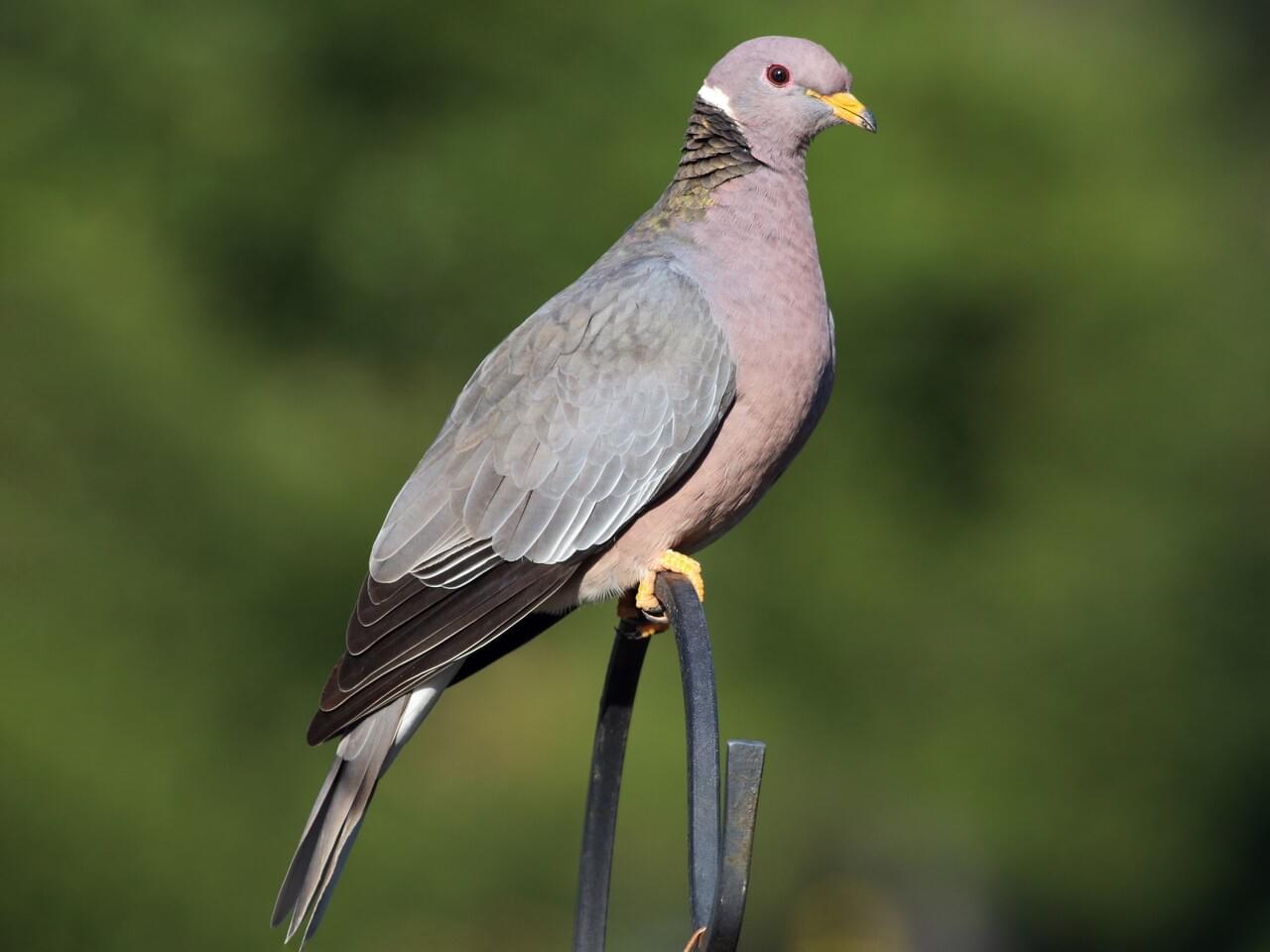
Photo courtesy of Paul Fenwick / Macaulay Library.
Often heard making slow, deep hooting calls in the early morning hours, the Band-tailed Pigeon can lead those with an untrained ear to believe an owl is lurking nearby. They are about the size of a crow with small heads, long and rounded tails that feature a thick black band, and wide-based wings. Mostly blue-gray or purple-gray, the Band-tailed Pigeon has a white crescent on the back of the neck, and both the feet and bill are yellow. These pigeons are forest-dwellers that spend most of the time searching for nuts, fruit, and seeds in flocks of dozens to hundreds of individuals. They are friendly with their flock-mates and are not known to fight over food. Their flocking behavior is though to protect them against predators like Peregrine Falcons, Cooper’s Hawks, and Great Horned Owls. Band-tailed Pigeons build saucer-shaped nests of twigs about 8 inches in diameter on broad, sturdy branches and lay just one or two eggs per clutch in 1-3 broods per year. Breeding pairs are monogamous and both parents work to feed and keep the chicks warm. The courtship ritual occurs in the trees, with the male swinging his or standing tall with his beak pressed against his throat as he approaches the female. If she wishes to mate, she responds by bobbing her head up and down.
5. Wild Turkey (Meleagris gallopavo)
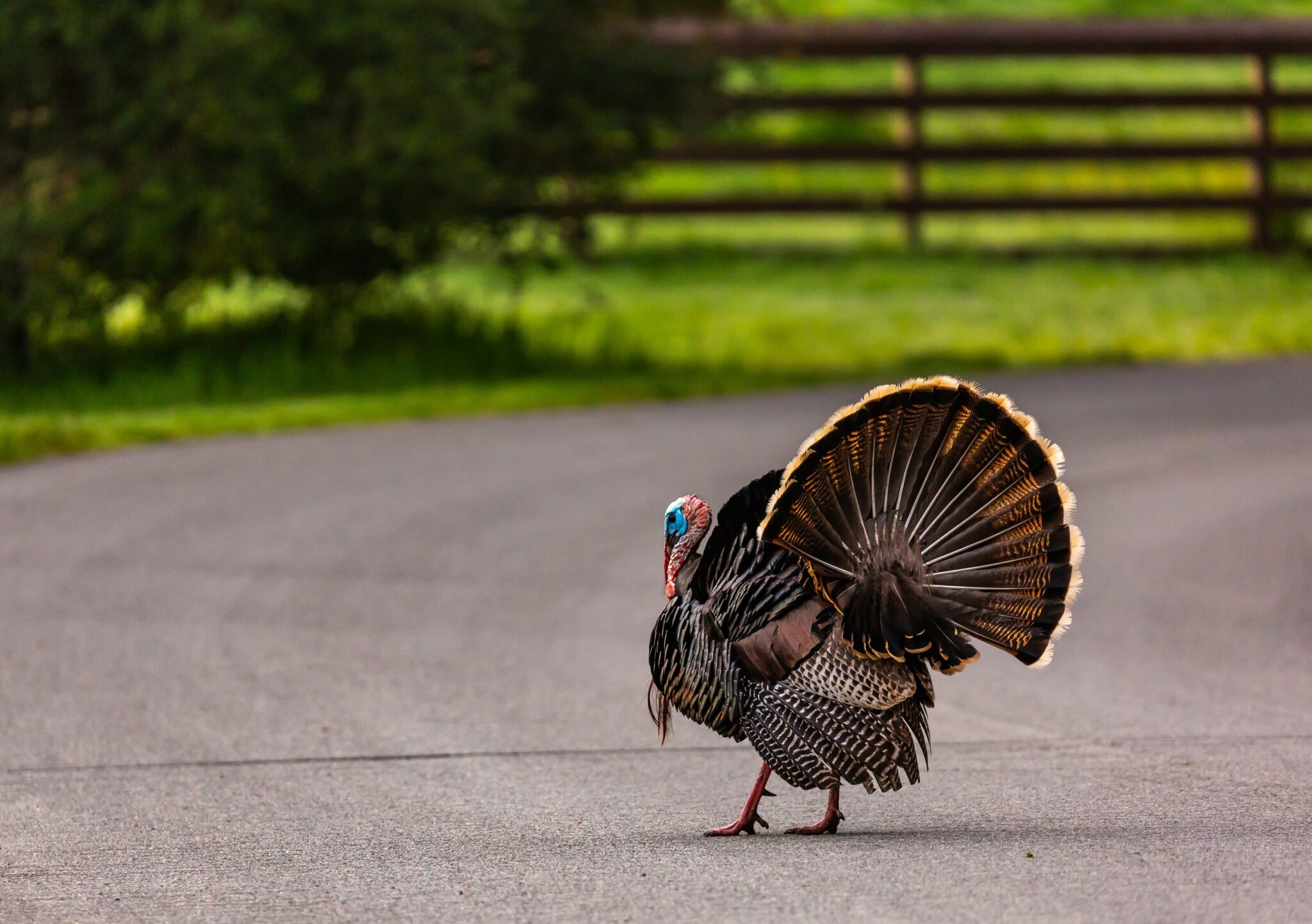
Photo by Serena Lasko.
Driving around The Preserve, you have probably had to stop for a group of Wild Turkeys as they slowly meandered across the street. Wild Turkeys live in open forests with regular clearings and forage in flocks for oak acorns, beech nuts, pecans, cherries, and other fruits and nuts. They will occasionally eat grass seeds, salamanders, snails, and beetles to supplement their diet. Courtship begins when the male gobbles, fans out his dramatic tail feathers, and struts around. To nest, the female turkey digs a shallow depression in the leaf litter at the base of a tree or beneath thick shrubbery about 1 inch deep and 8-11 inches in diameter. She lays 4-17 eggs per year, and after just one day, the are ready to fledge and follow their mother around. Breeding females rear the chicks without help from their polyamorous mate, though they may join up with other breeding females to raise their chicks together. Outside of the breeding season, males form all-male flocks. The Wild Turkey is a non-native bird introduced by the California Fish and Game Commission as part of a state-sponsored recreational hunting initiative in the 1870s.
6. Anna’s Hummingbird (Calypte anna)
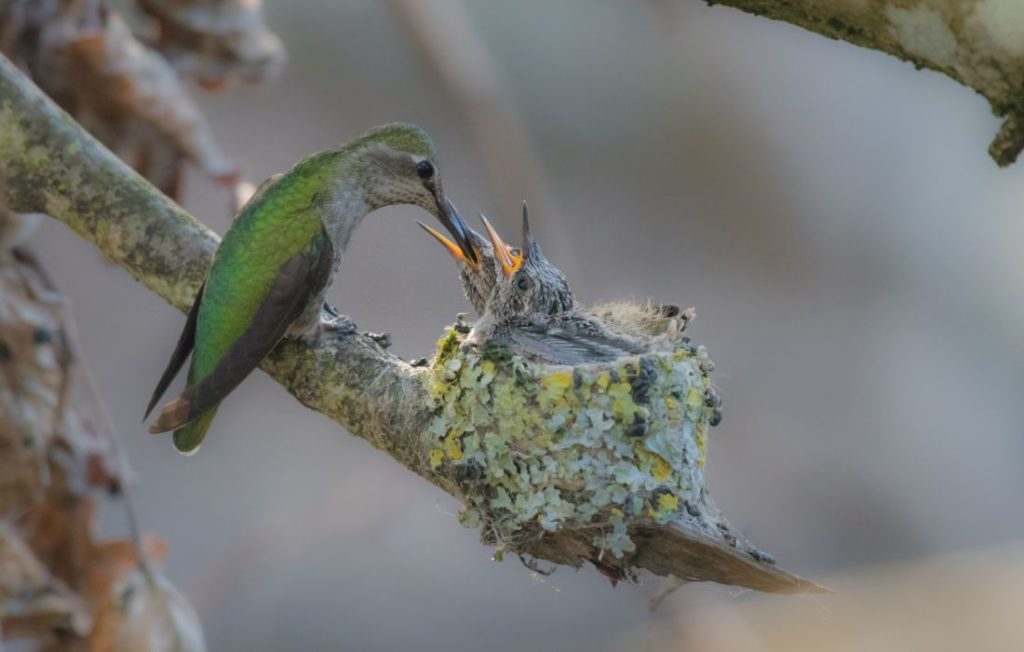
Photo courtesy of Tara Lemezis / Portland Audubon.
Anna’s Hummingbirds are tiny, fast-moving birds with iridescent emerald bodies (or gray, depending on how the feathers catch the light), rose colored heads, and black needle-like beaks. Rotating their wings in a figure-eight pattern, these incredible flyers can hover in the air, appearing motionless. Their wings beat about 40-50 times per second and they can go 25 miles per hour during a typical flight. All of this activity means they’re voracious eaters, consuming up to 50% of its body weight in nectar every day. Anna’s Hummingbirds are common in riparian habitats, savannas, coastal scrub, and backyards with feeders where they feast on the nectar of flowering plants including manzanita, currant, and gooseberry as well as small insects like midges and leaf hoppers. These hummingbirds live for about 8.5 years and are fiercely territorial, defending an area of about ¼ acre. So, if you think you’re seeing the same hummingbird at your feeder every day, you very well may be. The female builds a nest 1 inch deep and 1.5 inches wide (about the size of a walnut) constructed of plant down, moss, and spiderwebs and lays just 2 eggs at a time (the size of a jelly bean), with 2-3 broods per year.
7. Red-tailed Hawk (Buteo jamaicensis)
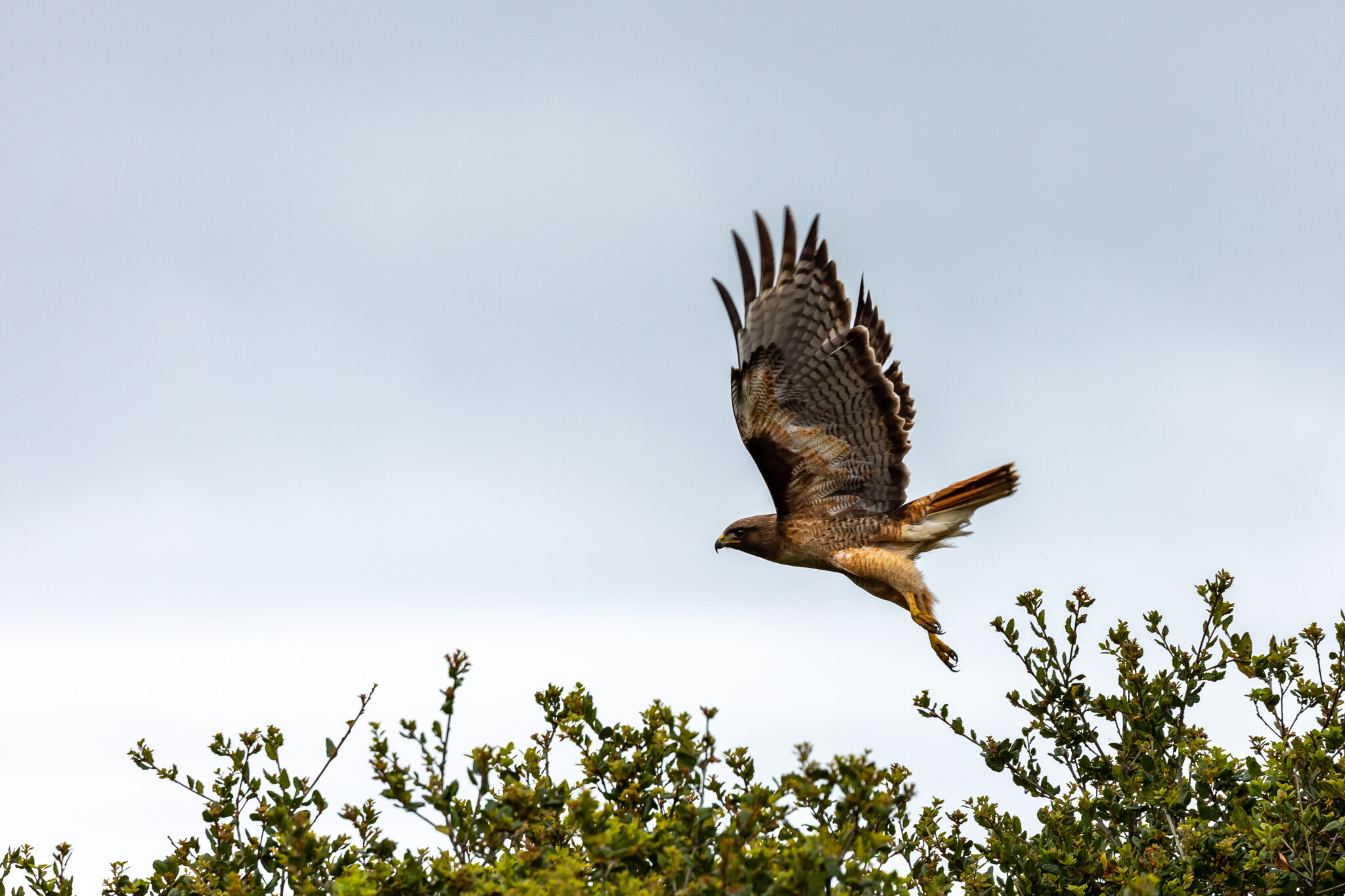
Photo by Serena Lasko.
The Red-tailed Hawk is the most common hawk species across North America, and the most common raptor seen on the Santa Lucia Preserve after the Turkey Vulture. They are large with a 4-foot wingspan and a butero shape, meaning broad, rounded wings and a short tail. Because they share this shape with other raptor species, the easiest way to distinguish them is by their shrill, raspy “keeeeeer” call that is commonly used in Hollywood movies as a stand-in for any raptor species. They often have a reddish tail (as their name suggests) and pale bellies, but don’t be fooled, the Red-Tailed Hawk comes in many different color variations. In the words of Mike Stake, “when in doubt, it’s a Red-tailed Hawk.” To hunt, they either perch motionless in trees along roadsides and near wide open spaces, or hang in the air scanning for prey below. Breeding season begins in the spring and the courtship flight is a sight to behold. The pair soars in wide circles at a great height, then the male dives down and shoots back up several times, approaching the female from above to touch her briefly with his legs. Sometimes the female will latch onto the males extended legs and they will plummet towards the ground in spirals.
8. Yellow-rumped Warbler (Setophaga coronata)
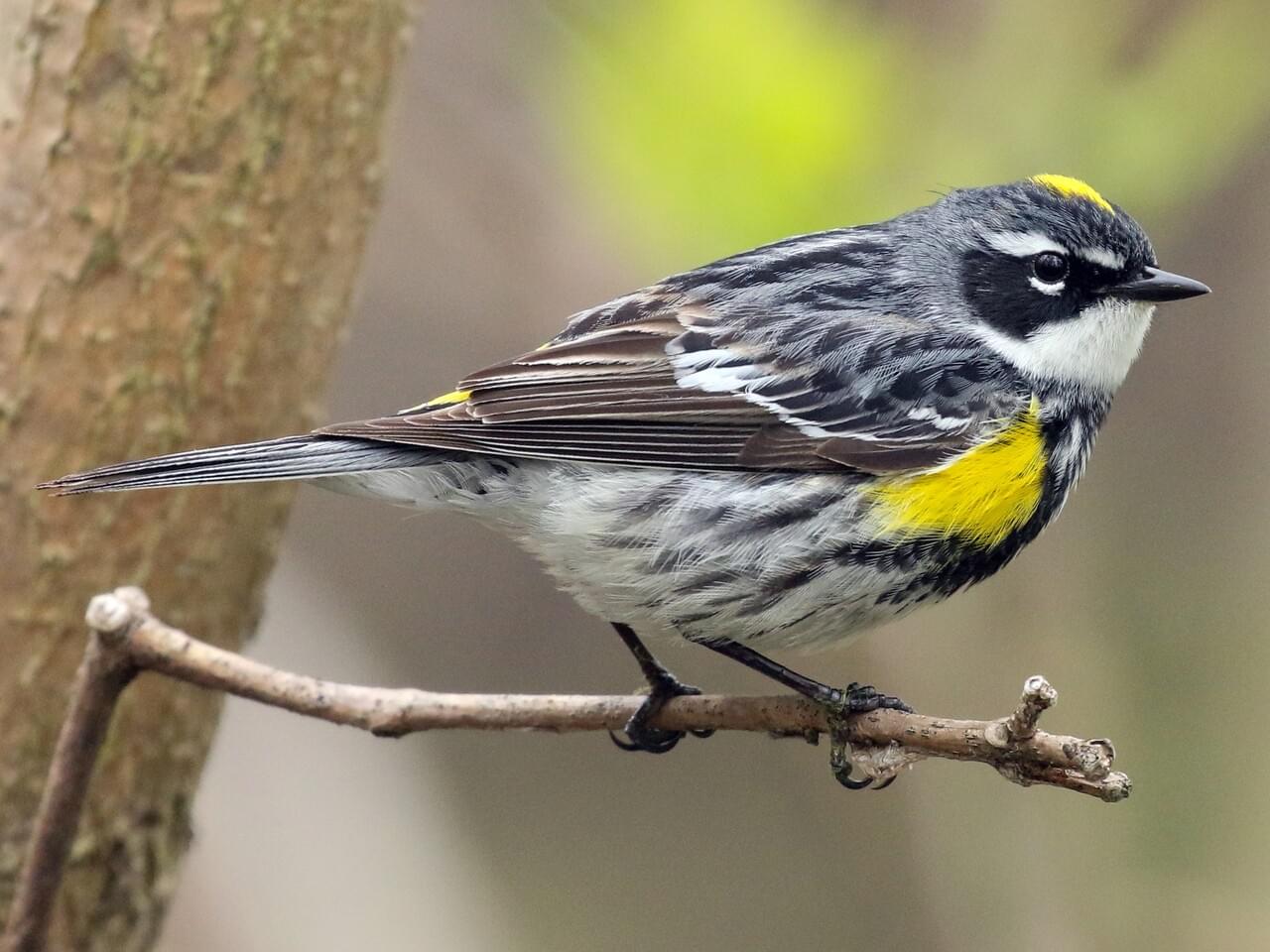
Photo courtesy of Ezra Staengl / Macaulay Library.
Producing soft, sweet trills and up-beat chips in mixed coniferous and streamside forests, your fall/winter day has likely been brightened by the calls of the Yellow-rumped Warbler flitting through the tree canopy and fanning their tails. Yellow-rumped warblers winter on the California Central Coast and are often seen foraging in a wide variety of habitats. Similar in appearance to the Townsend’s Warbler, the Yellow-rumped Warbler is aptly named for the bold yellow patch on its behind, just above the tail feathers. They may also have yellow patches on the top of their head, under the chin, and on either side of the chest. Otherwise, they are a mixed pattern of white, black, and sometimes brown in females. The Yellow-rumped Warbler is an omnivorous generalist, eating insects, fruits like bayberry and wax myrtle, juniper, poison oak, and dogwood, and grass seeds. This warbler nests on the horizontal branch of a conifer, with the female in charge of the building and the male sometimes gathering materials including twigs, pine needles, grasses, mammal hair, moss, and lichen. It is about 3-4 inches across and 2 inches deep. The oldest recorded of this species was a 10-year-old female recaptured and released in Wyoming in 2006.
9. Acorn Woodpecker (Melanerpes formicivorus)
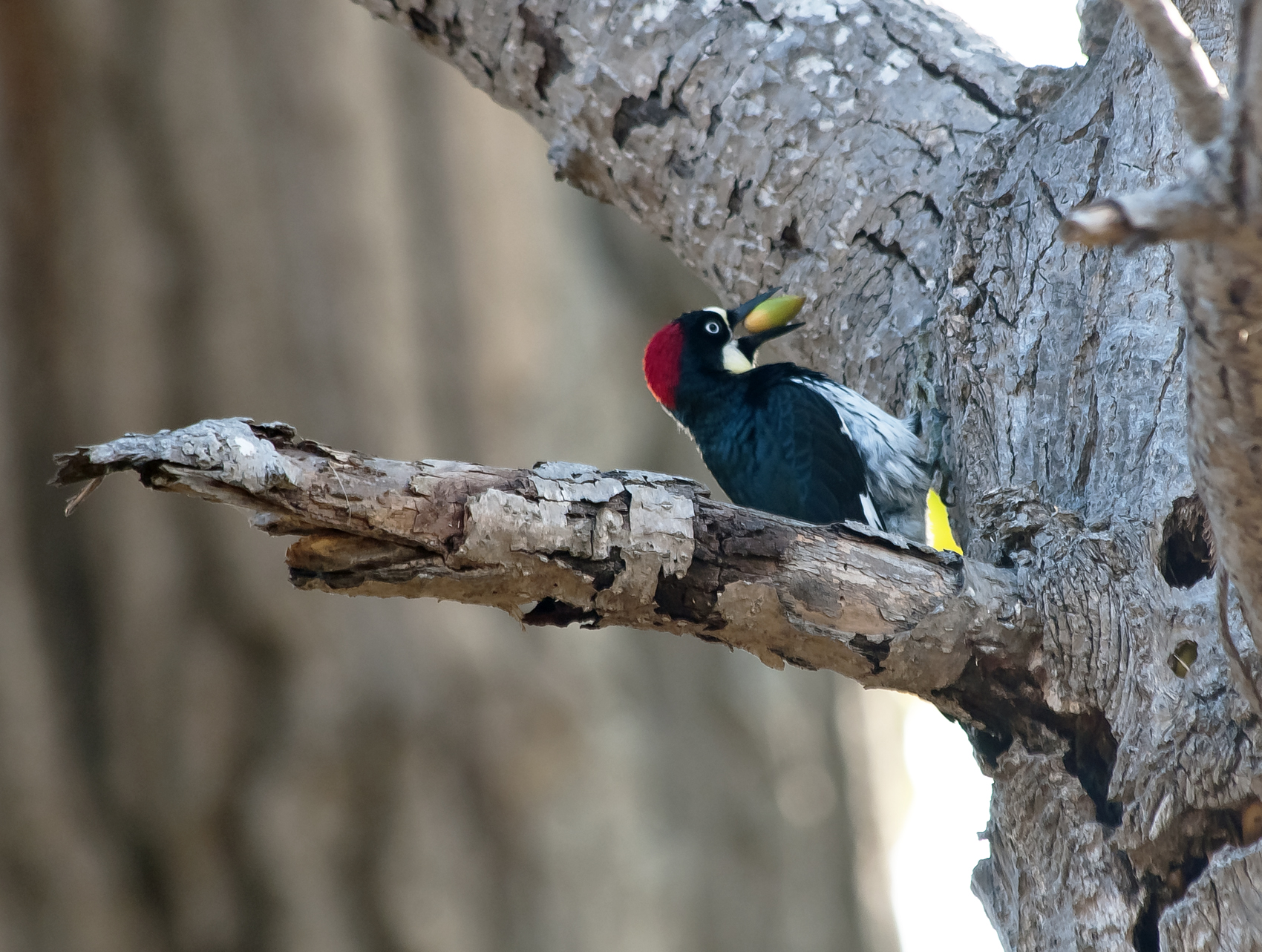
Photo by Chuck Bancroft.
Clownish, wide-eyed, and topped with a red cap, you have likely seen Acorn Woodpeckers socializing in oak savannas and woodlands with a loud “waka-waka-waka” call. This woodpecker is named for its winter diet and the unusual behaviors it has formed around it. Acorn Woodpeckers famously create a communal granary by drilling up to 50,000 holes in a tree snag, dead branch on a living tree, or telephone pole. They then collect and store an acorn to fit each hole. The open setting of the granary requires the birds to be on guard, defending their winter store and the 15-acre territory surrounding it from squirrels, jays, nuthatches, and other thieves. Maintenance of the granary takes a lot of work, as each acorn needs to be perfectly fitted to its hole and moved when it dries or shrinks. To share the labor, Acorn Woodpeckers form family groups of about one dozen individuals, known as a “bushel.” Breeding pairs nest in the same cavity, producing between 3-7 eggs per clutch and 1-2 broods per year. With a cooperative approach to everything they do, the young are fed by all in the family group. While they do rely on their store of acorns in the winter, it may only make up half of their annual diet, with insects, tree sap, seeds, and sometimes the eggs of other birds making up the other half.
Please note that this is not an exhaustive list of birds in the region. For more bird resources, please visit the Monterey Audubon Society website, check out The Sibley Field Guide to Birds of Western North America, or contact Conservation Ecologist Dr. Brian Woodward at [email protected].